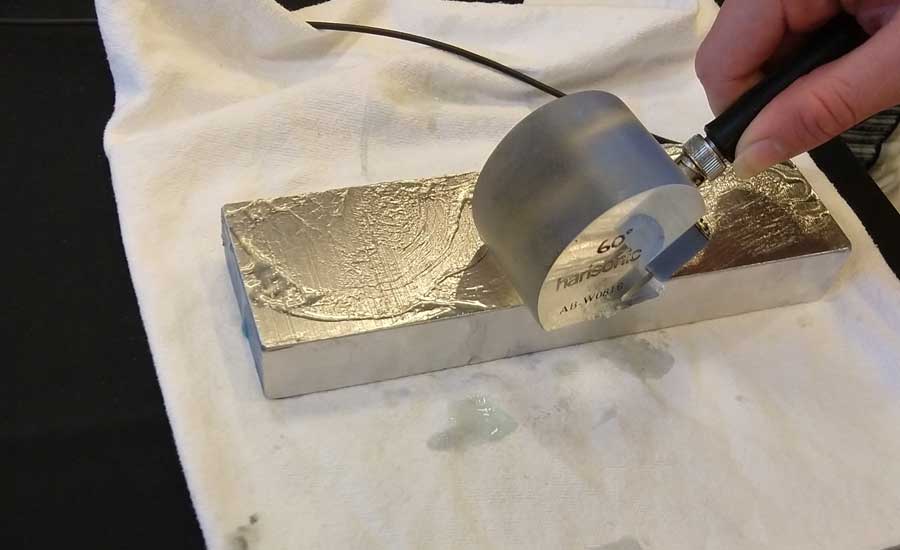Nondestructive testing (NDT) is the most important industry you’ve never heard of. That’s how I typically start a STEM (science, technology, engineering, and math) demonstration. We all know the importance of the work of scientists and engineers and health professionals. Few people are aware of the testing which is performed on the materials we use every day, and which affects every aspect of our lives.
NDT is a collection of test methods which detect defects in materials without damaging the materials. It is used in nearly every imaginable industry. The cars we drive, the bridges we cross, the aircraft we fly in, the power plants which supply our energy; NDT plays a critical role in ensuring the safety of nearly everything our modern world depends on.
But the average age of an NDT practitioner is currently in the mid-40’s. The NDT workforce is aging, and it is up to NDT practitioners to spread the word about this important industry and attract new people to work with us.
In one form or another, six questions will be on the minds of young people who might be interested in NDT as a career.
- What is NDT?
- Who can do NDT?
- When should I start considering this field?
- Where can I do NDT?
- Why should I do NDT?
- How do I start an NDT career?
It’s easy, when introducing students to a highly technical career field unknown to them, to spend a lot of time describing how the technology works. It’s easy to get into long descriptions of the physics behind the test methods, and the sorts of materials which are tested.
That won’t answer some of the most important questions a student will have. The physics might be fascinating, but a student thinking about the future will more likely be thinking, “Is it interesting work? Is it important work? Can I make a living doing this work?” The goal of this article is to give pointers toward answering questions like these.
WHAT
It’s easy to assume that “What” refers only to the physics of NDT. It’s certainly worthwhile to spend time explaining how the test methods work. A hands-on demonstration is an ideal way to do this.
It’s also worthwhile to explain what NDT is used for. NDT is used in every industry imaginable, from assessing that something has been polished properly to making sure that the internal parts of jet engines won’t break. It ensures that the materials we use won’t break prematurely from unknown defects. As our machines and processes become bigger (or smaller) and more powerful, material failures become more dangerous. NDT helps prevent those failures.
The key for promoting this to students is to emphasize the wide scope of what NDT covers, from the materials tested to the variety of test methods, and then highlight how important it is that the materials used in these applications don’t contain unacceptable defects.
WHO
Who can do NDT? Or, as a student might ask it, “Can I do this?” Almost anyone can. The necessary mindset is the most important thing. Can you learn just a little math? Do you have a little courage? (It takes some courage to tell a production manager that a piece of material has failed testing.) Are you willing to work with the utmost integrity, especially in a world where honesty is sometimes seen as a liability?
At a recent STEM event, I assisted with informally giving a group a career aptitude survey. While certain aptitudes are more obviously applicable in NDT, all of them have their place. In this field, creativity and people skills are just as valuable as technical skills.
NDT is one of the few professional fields where advanced education is not needed to enter or to progress. A high school diploma is enough to begin training as a new hire. With time and experience, a technician can advance to more challenging work. (It’s worth noting that the author holds a degree in engineering. The author’s manager only has a high school diploma. This underscores the easy entry into the NDT field, and the potential to advance without advanced education.)
WHEN
As mentioned above, NDT practitioners are aging. The proper time to enter this field really is now. Companies that use NDT are constantly looking for good people to hire and train, and often will hire without experience in NDT. The field is short on new people, which gives interested people an advantage in hiring which they may not have in other fields.
For high school and college students especially, knowing that there is an industry which is actively looking for new people will be extremely interesting.
WHERE
NDT is performed all over the world. I work at a testing facility and hardly ever travel. Technicians at some other companies travel all over the world. The locations and amount of travel depend strongly on each organization that performs NDT, but options exist across the entire field.
Students who are interested in travel will naturally be interested in this prospect. Students who aren’t as interested in that can be assured that plenty of positions exist, especially at higher levels of certification, which involve little or no travel.

A student learning the basics of ultrasonic testing.
WHY
“Why should I do this?” One simple answer is, “Because not many people are.” NDT is a small field with great importance. It has plenty of room for growth, not just in the sense of growing businesses, but room for individuals to grow and acquire more skills and more responsibilities.
An additional benefit is the extreme sense of ethics in the NDT industry. Honesty really is the main product of NDT. When the author was hired, his manager said, “Your job is to be able to sleep at night.” There are numerous examples of questionable ethics in industry, but very few in NDT; and those few examples are infamous. In my view, no other industry exemplifies the term “honest work” as well as NDT does.
One way to spark interest in the field is to tell stories. One well-regarded NDT expert has tested components of numerous roller coasters and other amusement park attractions. Another has tested the boiler of an old steam locomotive which was being reconditioned. Others have tested critical components of aircraft and power plants. Stories of things you have tested put a personal touch on the field and can underscore how NDT touches everyone’s lives.
HOW
If the current workforce of NDT practitioners has been successful in creating interest in the field by answering the questions above, the younger generations will want to know how they can start their NDT careers.
For those who want to get into the field right away without spending any more time in school than absolutely necessary, a high school diploma is enough to get started. It can be the longest road to advanced positions and responsibilities, but can give good rewards even early in the career. A student who wants to take this path should still concentrate on science and mathematics as much as possible in high school.
For those who want to follow a more traditional path of a high school diploma plus specific technical training, there are numerous NDT educational programs all over the country. Researching which programs are located in your area will help you provide information about this career path.
For those who want to pursue NDT as a professional field, a degree in engineering or a physical science is an ideal start (this was my path). The degree can shorten the time required for advanced NDT certifications and provides an excellent educational foundation for learning the various test methods. NDT is also an excellent field for someone with a degree who is unsure what path to take, or wants a career with more flexibility.
NDT is a growing field, with plenty of opportunity, but not enough people to fill those opportunities. Promoting NDT to young people is a necessary step in maintaining the safety and reliability of the materials we use every day.



